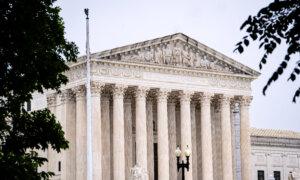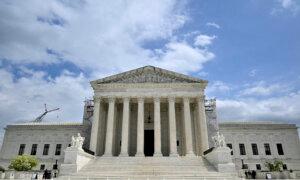The justices agreed in judgment but disagreed in how they reached their conclusions.
The Supreme Court ruled on June 13 against an attorney claiming that federal law violates the First Amendment by prohibiting him from trademarking the insult “Trump too small.”
That phrase is a double entendre emanating from an exchange between then-candidate Donald Trump and Sen. Marco Rubio (R-Fla.) during one of the 2016 Republican presidential primary debates.
The Patent and Trademark Office denied attorney Steve Elster’s attempt to trademark the phrase because of the Lanham Act, which contains a clause prohibiting registration of a mark that consists of an individual’s name without their consent.
While the justices unanimously agreed that the Lanham Act didn’t violate the First Amendment, they fractured along multiple lines in reaching that conclusion.
Justice Thomas wrote the majority opinion, in which Justices Samuel Alito and Neil Gorsuch joined in full. The majority opinion focused on U.S. legal history and tradition in upholding Lanham while avoiding additional rules surrounding how to evaluate similar First Amendment claims.
“Our decision today is narrow,” Justice Thomas wrote. “We do not set forth a comprehensive framework for judging whether all content-based but viewpoint-neutral trademark restrictions are constitutional. Nor do we suggest that an equivalent history and tradition is required to uphold every content-based trademark restriction. We hold only that history and tradition establish that the particular restriction before us, the names clause in §1052(c), does not violate the First Amendment.”
Chief Justice John Roberts and Justice Brett Kavanaugh joined all of the majority opinion except its third part, which criticized approaches advanced by Justices Amy Coney Barrett and Sonia Sotomayor in their concurrences.
“I agree with the Court that the names clause is constitutional, particularly in light of the long history of restricting the use of another’s name in a trademark,” Justice Kavanaugh wrote. “In my view, a viewpoint-neutral, content-based trademark restriction might well be constitutional even absent such a historical pedigree.”
Criticism From Barrett and Sotomayor
Justice Barrett wrote in a concurrence, joined by Justice Elena Kagan, that while she agreed that the names clause does not violate the First Amendment, she disagreed with some of the majority’s reasoning.
“The Court claims that ‘history and tradition’ settle the constitutionality of the names clause, rendering it unnecessary to adopt a standard for gauging whether a content-based trademark registration restriction abridges the right to free speech,” she said. “That is wrong twice over.”
Justice Barrett’s opinion was also partially joined by Justice Sotomayor and Justice Ketanji Brown Jackson.
Both Justice Barrett’s and Justice Sotomayor’s opinions criticized the majority’s focus on history and tradition to resolve the case. Justice Barrett described the majority’s evidence as “loosely related cases” and questioned whether “hunting for historical forebears on a restriction-by-restriction basis is the right way to analyze the constitutional question.”
Justice Sotomayor was also critical, saying the majority had “drawn conclusive inferences from its historical evidence, all without any guidance from the litigants or the court below” and that “in-chambers historical research by nonhistorians raises more questions than answers.”

Fractured Unanimity
The fractured nature of the June 13 decision was similar to the court’s opinions in Trump v. Anderson, which overruled the Colorado Supreme Court’s holding that former President Trump was disqualified from appearing on the state’s ballot.
In both cases, Justice Barrett joined the court’s liberal cohort in taking a different approach than the five other conservative justices and authoring her own opinion. Both she and the liberal justices suggested in Trump v. Anderson that the other five went too far in discussing Congress’ role in enforcing Section Three of the 14th Amendment.
Justice Sotomayor’s concurrence on June 13 repeatedly described the court’s opinion as a “five-Justice majority opinion.” Both Justices Barrett and Sotomayor, despite authoring different concurrences, seemed to agree in their criticism of the majority’s approach as well as in the need for a legal standard to evaluate the types of claims brought by Mr. Elster.
Justice Sotomayor did not join a portion of Justice Barrett’s concurrence where the latter delved deeper into historical evidence.
Part of the former’s concurrence took issue with how the majority and Justice Barrett focused on history. Their “back-and-forth,” she said, “highlights the indeterminacy of the Court’s history-and-tradition inquiry, which one might aptly describe as the equivalent of entering a crowded cocktail party and looking over everyone’s heads to find your friends.”
Original News Source Link – Epoch Times
Running For Office? Conservative Campaign Consulting – Election Day Strategies!


